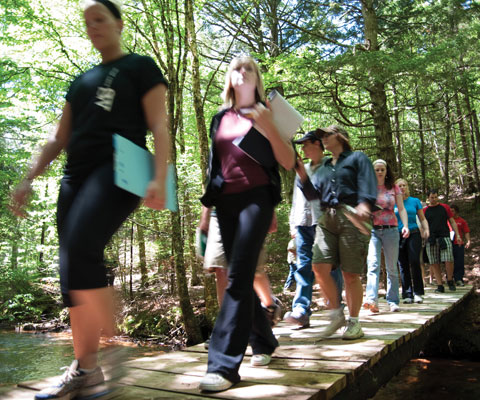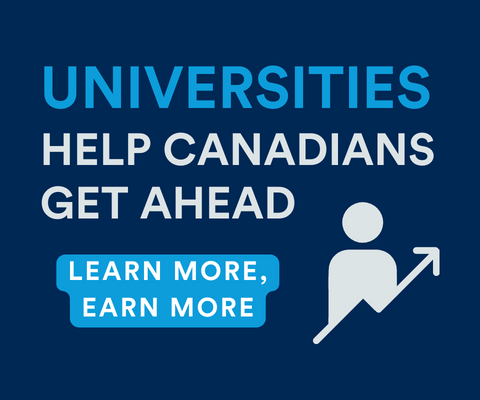Facts and stats
Get the most up-to-date statistics on Canadian universities.
Overview
-
1.44Mstudents at Canadian universities
Universities welcome approximately 1.44 million full-time and part-time students back to school annually.
-
2.1Mnew jobs
Between March 2012 and March 2022, 2,169,700 new jobs were created for university graduates, three times as many as those created for graduates of all other types of postsecondary education combined.
-
$40Benterprise
As a $40 billion enterprise in direct expenditures, universities are significant drivers of economic prosperity. They provide employment for close to 410,000 people.
Data tables
Indigenous education
Closing the gap for Indigenous students
-
90%increasing Indigenous leadership
90% of institutions are working to increase Indigenous representation among faculty and staff and improve retention.
-
65%Indigenizing research
Two-thirds of universities are incorporating Indigenous knowledge, methods and protocols into research and teaching policies, programs and practices.
-
78%offer intercultural engagement
78% of universities promote intercultural engagement through cultural activities, events, talking circles and cultural competency or reconciliation training.
-
69%do community outreach
More than two-thirds of Canadian universities reach out to prospective Indigenous students to inform them of available services, programs and supports.
-
85%partner with Indigenous communities
More than 80% of universities have a partnership with Indigenous communities and organizations to foster dialogue and reconciliation.
-
89%working to integrate Indigenous Knowledges
Nearly 90% of institutions are working to integrate Indigenous Knowledges and teaching methods into classrooms on campus.
Hands-on learning
Providing students with career-boosting learning opportunities
-
80%of employers
Four out of five employers surveyed say co-op and internship students are a source of new talent and potential future employees.
-
56%benefit from hands-on learning
More than half of today’s undergraduates benefit from experiential learning – such as co-ops, internships and service learning – as part of their university education.
-
25%growth in co-ops
Enrolment in co-op programs at universities has jumped by 25 percent in recent years, from 53,000 students in 2006 to 65,000 students in 2013.
-
$65K+Arts grads earn good incomes
Social science and humanities grads share in the income premium for university graduates. For example, full-time workers with degrees in history earn, on average, above $65,000 annually.
-
60university entrepreneurial hubs
Canadian universities are home to more than 60 business incubators, accelerators and start-up programs that help fuel Canada’s entrepreneurial economic growth.
-
55%of leaders are liberal arts grads
The social sciences and humanities make up more than half of bachelor’s degrees among current professional leaders with higher education qualifications, across 30 countries and all sectors.
Studying across borders
Fostering cross-cultural competencies and adaptability
-
11%study abroad
Only 11% of Canadian undergraduates undertake an international mobility experience over the course of their degree, despite the clear benefits of global study to building future skills.
-
80%see career benefit
More than 80% of employers that hire graduates with international and intercultural experience say these recruits enhance their company’s competitiveness.
-
91%of universities say funding a challenge
Although 78% of universities provide some funding to support study abroad initiatives, 91% say that lack of funds is one of the top three reasons for low student mobility rates.
-
10%of students leave their province
Current estimates suggest that only one in 10 young Canadians crosses a provincial border to complete their university degree.
-
97%offer international experiences
The majority of universities offer their students international experiences such as academic coursework, field schools, volunteer work, research abroad and foreign work experience.
-
2/3of managers say Canada at risk
Two out of three hiring managers say Canada is at risk of being left behind dynamic global economies like China, India and Brazil unless young Canadians learn to think more globally.
Research and innovation
Positioning Canada as a global leader in research and innovation
-
$16Bin R&D
Universities performed $16 billion in R&D in 2022, accounting for 40 percent of total Canadian research and development.
-
$1.2Bin research for business
Canada’s universities conduct $1.2 billion in research for businesses and help build their competitive advantage.
-
$1.5Bin research for not-for-profit sector
Universities conduct $1.5 billion in research annually for the not-for-profit sector, which has more than tripled since 2000.
-
1,500companies in university research parks
Nearly 1,500 companies and government labs are located in 26 university research and technology parks. They employ about 65,000 people and generate $4.3 billion in GDP.
-
40%of faculty are internationally trained
40% of faculty at Canadian universities have at least one international degree.
-
30%decrease in funding
A shift in funding away from federal research councils caused a decrease of over 30% in available real resources per researcher, between 2007 and 2015.






